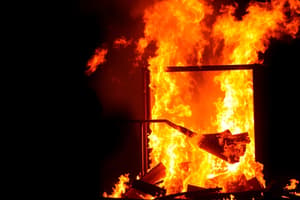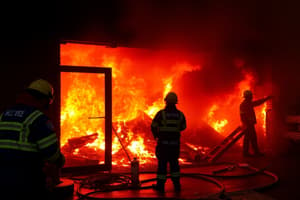Podcast
Questions and Answers
What must a fire investigation report primarily ensure regarding its conclusions?
What must a fire investigation report primarily ensure regarding its conclusions?
- It adheres to a personal narrative style for easier understanding.
- It is supported by evidence and analysis gathered throughout the investigation. (correct)
- It summarizes public opinions gathered during the investigation.
- It includes recommendations for future fire safety improvements.
Which often overlooked aspect is essential for evaluating human actions in fire incidents?
Which often overlooked aspect is essential for evaluating human actions in fire incidents?
- The fire suppression techniques used. (correct)
- The complexity of the building's structure.
- The speed of the fire department's response.
- The opinions of the bystanders present.
Why is it important to follow proper chain of custody procedures during a fire investigation?
Why is it important to follow proper chain of custody procedures during a fire investigation?
- To keep evidence easily accessible for public viewing.
- To ensure that evidence can be discarded if necessary.
- To maintain the integrity and reliability of the evidence collected. (correct)
- To allow investigators to alter evidence as needed.
What characteristics should a fire investigation report possess to be effective?
What characteristics should a fire investigation report possess to be effective?
What should reports specifically identify regarding fire incidents?
What should reports specifically identify regarding fire incidents?
What is the primary goal of the fire cause and origin investigation process?
What is the primary goal of the fire cause and origin investigation process?
Which factors should fire investigators consider when evaluating the cause of a fire?
Which factors should fire investigators consider when evaluating the cause of a fire?
What role does methodical documentation play in a fire investigation?
What role does methodical documentation play in a fire investigation?
Which element is NOT typically considered during preliminary observations at a fire scene?
Which element is NOT typically considered during preliminary observations at a fire scene?
Which aspect of fire dynamics must fire investigators understand to identify ignition sources?
Which aspect of fire dynamics must fire investigators understand to identify ignition sources?
What type of evidence should be documented meticulously during a fire investigation?
What type of evidence should be documented meticulously during a fire investigation?
Why is it crucial for fire investigators to establish a sequence of events during an investigation?
Why is it crucial for fire investigators to establish a sequence of events during an investigation?
In fire origin investigation, which of the following is crucial for assessing the reliability of evidence?
In fire origin investigation, which of the following is crucial for assessing the reliability of evidence?
Flashcards
Fire Origin and Cause Investigation
Fire Origin and Cause Investigation
The process of examining and determining the cause and origin of a fire, focusing on the location where the fire began and the factors that led to its ignition.
Fire Investigation Report
Fire Investigation Report
A formal document that summarizes the findings of a fire investigation, providing a detailed account of the cause, origin, and contributing factors of the fire.
Chain of Custody
Chain of Custody
The collection of evidence related to the fire, including physical items, witness statements, and documentations, which must be properly handled and stored to maintain its integrity and legal admissibility.
Report Clarity and Scientific Soundness
Report Clarity and Scientific Soundness
Signup and view all the flashcards
Evaluation of Response and Occupant Actions
Evaluation of Response and Occupant Actions
Signup and view all the flashcards
Fire Point of Origin
Fire Point of Origin
Signup and view all the flashcards
Fire Patterns
Fire Patterns
Signup and view all the flashcards
Scene Assessment
Scene Assessment
Signup and view all the flashcards
Evidence Documentation
Evidence Documentation
Signup and view all the flashcards
Fire Dynamics
Fire Dynamics
Signup and view all the flashcards
Sequence of Actions
Sequence of Actions
Signup and view all the flashcards
Contributing Factors
Contributing Factors
Signup and view all the flashcards
Evidence Evaluation
Evidence Evaluation
Signup and view all the flashcards
Study Notes
NFPA 921 Chapter 12: Fire Cause and Origin Investigation
- Chapter 12 of NFPA 921 details the analytical process for determining fire origin and cause, from initial observations to final conclusions.
- The meticulous investigation relies on scientific methodology, logical reasoning, and factual evidence. The initial focus is identifying and evaluating potential contributing factors.
- Fire investigations involve collecting, handling, and documenting physical and testimonial evidence.
Fire Scene Examination
- Scene exploration starts with identifying the fire's origin, guiding the investigation type. Preliminary observations prioritize identifying the most likely cause.
- Analyzing heat, smoke damage, and fire patterns aids in understanding ignition, spread, and progression.
- Examine building components and contents for mechanical failures, electrical issues, structural defects, and other potential ignition sources.
Evidence Documentation
- Detailed documentation (sketches, photos, measurements) is crucial for all observations and evidence.
- All items of interest, including potential ignition sources, need thorough documentation of location, condition, and anomalies.
- Comprehensive documentation aids report accuracy and admissibility in court.
Analytical Methods and Considerations
- Understanding fire dynamics (fuels, oxygen, heat) is vital for the investigation. Investigators require expertise in fire behavior.
- Establishing the order of events and sequence of actions aids in identifying potential ignition sources.
- Evaluating environmental factors, hazardous materials, and human actions is crucial for determining the fire cause.
- Assess the reliability and validity of all evidence and testimony, considering how actions contributed to the fire.
- Assess the fire suppression efforts and actions of occupants.
Reporting
- The cause and origin report is based on detailed observations, expert opinions, and documented evidence.
- Reports should be well-structured, clear, concise, scientifically sound, and use appropriate technical terms.
- Conclusions must be supported by evidence and analysis.
- The report must clearly identify the fire origin, cause, and contributing factors, if possible.
- Maintain proper chain of custody for evidence throughout, ensuring proper security and documentation.
Studying That Suits You
Use AI to generate personalized quizzes and flashcards to suit your learning preferences.



